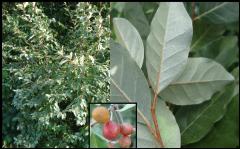Elaeagnus umbellata

Silvery scales on the undersides of leaves, on stems, and even on red autumn berries help identify autumn-olive.
Photographer: Ronald Kielb, CC BY-NC
Find out more on NatureServe Explorer
Search for photos of this species within the NatureServe Flickr photo stream.
Autumn-olive is a shrub from eastern Asia, and has become an aggressively invasive non-native plant in many central and eastern U.S. forests, taking over the understory where it becomes established and creating dense shade. It can even tolerate drought and nutrient-poor soils.
Autumn-olive produces its own nitrogen in infertile soils, with the help of soil bacteria (Munger 2003). This increases the fertility of the soils immediately around its roots wherever it grows. That can enable other weedy plant species to thrive in nutrient-poor soil, threatening natural communities composed of native plants adapted to those soils.
Deer browse and other forms of pruning actually stimulate the growth of autumn-olive.


